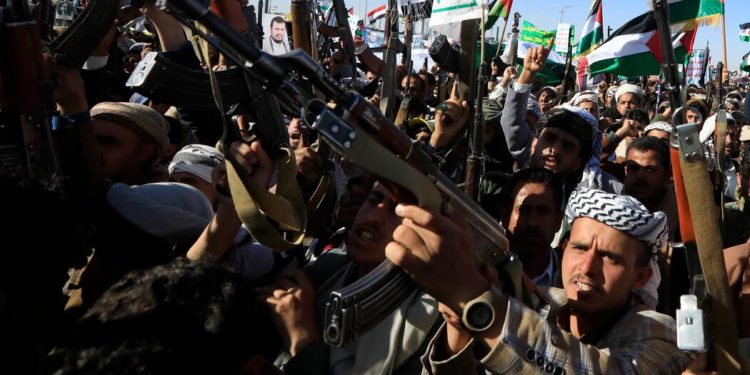By THE NEW YORK TIMES
The United States and Britain carried out another round of large-scale military strikes Saturday against multiple sites in Yemen controlled by Houthi militants, U.S. officials said.
The strikes were intended to degrade the Iran-backed militants’ ability to attack ships in sea lanes that are critical for global trade, a campaign they have carried out for almost four months.
American and British warplanes hit missile systems and launchers and other targets, the officials said. Australia, Bahrain, Canada, Denmark, the Netherlands and New Zealand provided support for the operation, according to a joint statement from the countries involved that was emailed to reporters by the Defense Department.
The strikes, which the statement called “necessary and proportionate,” hit 18 targets across eight locations in Yemen associated with Houthi underground weapons storage facilities, missile storage facilities, one-way attack unmanned aerial systems, air defense systems, radars and a helicopter.
“These precision strikes are intended to disrupt and degrade the capabilities that the Houthis use to threaten global trade, naval vessels, and the lives of innocent mariners in one of the world’s most critical waterways,” the statement said.
The strikes were the largest salvo since the allies struck Houthi targets on Feb. 3 and came after a week in which the Houthis have launched attack drones and cruise and ballistic missiles at vessels in the Red Sea and the Gulf of Aden.
On Monday, Houthi militants fired two anti-ship ballistic missiles at a cargo ship, U.S. Central Command said in a statement. The ship, called the Sea Champion, continued on to its destination at the port of Aden in Yemen, the statement added. Central Command reported several other tit-for-tat attacks that day between U.S. forces in the area and Houthis.
On Thursday, it was more of the same. American warplanes and a ship belonging to a member of the U.S.-led coalition shot down six Houthi attack drones in the Red Sea, Central Command said in another statement. The drones were “likely targeting U.S. and coalition warships and were an imminent threat,” it added.
Later that day, the statement said, the Houthis fired two anti-ship ballistic missiles from southern Yemen into the Gulf of Aden, hitting the Islander, a Palau-flagged, Britain-owned cargo carrier. The vessel was damaged, and one person had a minor injury.
And earlier on Saturday, the naval destroyer U.S.S. Mason shot down what Central Command said was an anti-ship ballistic missile launched from Yemen into the Gulf of Aden.
The Houthis say their attacks are a protest against Israel’s military campaign in Gaza, which was launched in response to attacks by Hamas in Israel on Oct. 7.
The American-led retaliatory air and naval strikes against Houthi targets began last month.
“The Houthis’ now more than 45 attacks on commercial and naval vessels since mid-November constitute a threat to the global economy, as well as regional security and stability, and demand an international response,” the statement said.
The United States and several allies repeatedly warned the Houthis of serious consequences if the salvos did not stop. But the U.S.-led strikes have so far failed to deter the Houthis. Hundreds of ships have been forced to take a lengthy detour around southern Africa, driving up costs.
Of all the Iran-backed militias that had escalated hostilities in solidarity with Palestinians in Gaza, the Houthis have been perhaps the most difficult to restrain. While the Houthis have continued their attacks, Shiite militias in Iraq and Syria appear to be observing a period of quietude since the United States carried out a series of strikes against Iranian forces and the militias they support in Syria and Iraq on Feb. 2.
Middle East experts say that after nearly a decade of evading airstrikes in a war with Saudi Arabia, the Houthis have become skilled at concealing their weaponry, putting some of it in urban areas and shooting missiles from the backs of vehicles before scooting off.







Discussion about this post